PCh8 Lec1
(3/27/20, bes)
Chapter 8: The Vibrational and Rotational Spectroscopy of Diatomic Molecules
In chapter 7 we studied the 2D rotation, also known as the "rigid rotor" and 3D rotation which led to a theoretical understanding of these quantum mechanical models. In lab we studied the experimental IR data for HCl and determined the average internuclear spacing. In chapter 8 we will blend these two topics together.
Section 8.1
READ section...
- Make particular note of Table 8.1
Section 8.2
READ section...
- Up to this point most of you have thought about spectroscopy (the application of "light" to cause transition between quantized energy states) in terms of absorption. In UV-Vis spectroscopy, as we learned from the PIB/conjugated π-electrons example, light energy is absorbed resulting in an electron making an transition from a lower energy state to a higher energy state. Absorption is the simplest form of spectroscopy. The reason we only discuss absorption in UV-Vis spectroscopy is that the lower energy level is highly populated and the higher energy level is not populated, so the only "process" that can occur is the absorption of light energy. The population of the energy levels is described by the Boltzmann Distribution (see beginning of Ch 2 and example problem 2.1).
- Consider watching this video (2:09 min) --> Boltzmann distribution explained
Question 1
Considering (from table 8.1) that the "spectral range" associated with a visible light is an energy ranging from 3e-19 --> 5e-19 J; this means that the energy level spacing is ~4e-19 J. So if you have two energy levels that are separated by 4e-19 J and each of these energy levels is singly-degenerate (meaning only 1 level each), if you have 1000 electrons in the system, how many of them are in the lower state at room temp (298 K)?
- 1) Write out the Boltzmann Distribution equation, note that subscript "i" indicates the higher energy and the subscript "j" indicates the lower energy.
- 2) Acknowledge that ni + nj = 1000,
- 3) You may choose the rewrite the Boltzmann equation using the variables shown in example problem 2.1 --> meaning ni = n2 and nj = n1, with energy level 1 < energy level 2.
- 4) as we did in lab awhile ago, having 2 unknowns (n1 and n2) and 2 equations, we can solve for n1 as shown in example problem 2.1
- 5) Plugging in the numbers, you will see that ALL of the electrons are in the lower n1 state. GET IT?
So the only spectroscopy that can occur is absorption of light energy resulting in an electron transitioning from the lower state to the higher state.
Question 2
Redo the above calculation for IR spectroscopy for the energy at the lower end of the range...energy separation of 2e-22J.
- - you should find that the population of the lower state is 512 and the higher state is 488.
So, what consequence does this have on the spectroscopy? It turns out that the probability of an electron absorbing light energy (going from lower level to higher level) is the same as the stimulated emission (going from the higher energy to the lower energy) and the only reason we see a "signal" is because there are more systems in the lower state than the higher state.
Question 3
Redo the calculation about for the IR spectroscopy for temperatures, 273 (ice water), 77 K (liq N2), and 4 K (liq He).
- Answers:
- - 273 K --> n1 = 513
- - 77 K --> n1 = 547
- - 4 K --> n1 = 974
- - So, lowering the temperature of your sample increases the number of systems in the lower energy and hence increases the "signal."
Spontaneous emission is related to fluorescence and will not be discussed any further here.
Section 8.3
READ section...
Notice that table 8.2 has the "experimental" and calculated data for a collection of diatomic molecules. Let's compare the haloacids:
- - ṽo (1H19(?)F) = 4138 cm-1
- - ṽo (1H35Cl) = 2991 cm-1
- - ṽo (1H79(?)Br) = 2649 cm-1
Notice that these above values are the m-value = 0 which is forbidden, although it can be determined from the experimental data...like you did yesterday.
Question 1
See example problem 8.2; calculate the force constant for each of these haloacids, i would suggest setting up an Excel file to do this for you...: (to calculate the reduced mass, use the value in this table)
- - Answers:
Question 2
In table 8.2, there is also population data for the two lowest vibrational states; please show how these calculations are done... (again consider using Excel)
Here is my Excel file:
End of Ch 8, Lec 1
